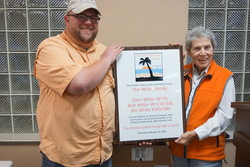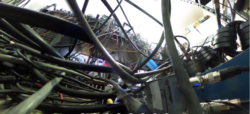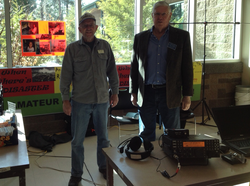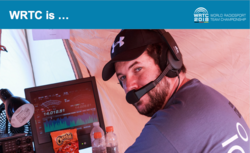 March 9, 2016 Editor: Paul Bourque, N1SFE | |||||
IN THIS ISSUE
NEW HF OPERATORS -- THINGS TO DO Sometimes one is NOT invited to the party, or invited to participate in a contest. Such is the case on March 12 when you may hear our Canadian neighbors and other stations in the "Commonwealth Call Areas" making contacts with United Kingdom and Crown Dependencies -- stations starting with the "G, GD, GI, GJ, GM, GU, and GW" prefixes, and their variants, as part of the Commonwealth Contest. As a US station, you'll be worth no points to them and they'll be disinclined to answer your calls. With five QSO Parties, a RTTY Sprint, and the Spring Stew Perry, the non-WARC bands will still be hopping the weekend of March 12-13. On the subsequent weekend, BARTG RTTY and three more QSO Parties could be to your liking. The BARTG contest offers a 6-hour entry class - SOAB6; you can work six consecutive hours of the 48-hour contest period. When you have other things that must be done over the weekend, it's nice to be able to have an entry class where you can still be competitive. BULLETINS Just when you thought it was time to pull in the beverages, emerge from the basement shack, and start sleeping at night, there's another Stew Perry event. March 12 and 13 will find 160 meters used for CW once again, with a distance and power-based scoring system that doesn't level the playing field so much as plow it up and plant a new crop. BUSTED QSOS Do NOT convert your Cut Numbers! Plain and simple, I was wrong when I mentioned in the last issue that one should convert cut numbers to the actual numbers while logging contacts. Just log what is sent, and submit that. The ARRL DX log scoring process will handle cut numbers just fine. From a past Contest Update: What happens if you enter "Cut Numbers" in QSO lines of a Cabrillo-formatted log? You'll be hearing lots of them in the upcoming ARRL DX CW Contest, so here's the straight scoop. First, the character string is read from the submitted log. Then...
Thanks to Matt, W1MSW; Ward, N0AX, and Jim, W8WTS. CONTEST SUMMARY Complete information for all contests follows the Conversation section March 10 March 11 March 12
March 13
March 14 March 15 March 16 March 17 March 18 March 19
March 20 March 21 March 23 NEWS, PRESS RELEASES, AND GENERAL INTEREST Current flows can also eddy. Experiments with graphene and electricity may have recently demonstrated that current flows can resemble flows of liquids, including characteristics like eddies and backward flows. Researchers detected the eddy phenomenon by measuring voltage gradients between various points on a graphene plane. The lighting industry continues to undergo changes -- General Electric is no longer going to produce Compact Fluorescent Lamps. Though CFLs captured 30% of the US light bulb sales at their height, they've now decreased to less than 15%. Consumers are favoring the qualities and economics of LED lighting. (Dennis, N6KI) Navigating the contract electronic manufacturing center that is China's Shenzhen could be made easier by The Essential Guide to Electronics in Shenzhen. The author has blogged about his experiences getting his projects built over the years, and has consolidated his expertise in this volume. Shenzhen's Hua Qiang is perhaps the new Akihabara... There's been continued progress in the use of quantum computing to attack problems that are difficult for traditional computing methods. The RSA cryptographic algorithms, for example, depend on the difficulty of using today's computing methods to factor large numbers. Researchers at MIT and University of Innsbruck have constructed a five qubit computer capable of factoring numbers using an algorithm first devised in 1994, but unimplemented in real hardware until now. They used a method to reduce the number of qubits needed to perform the calculation. It's still anticipated that today's encrypted data will be reasonably secure for another 20 years. The NSA does have an FAQ (PDF) on this topic, which curiously enough at the time of this publication is itself behind an invalid SSL certificate. If it's not already on the contest weekend menu, perhaps chocolate should be added to improve mental acuity, after the publishing of some recent research results. Especially if one does SO2R, as chocolate consumption could assist in "being able to do two things at once, like talking and driving at the same time." Crowdfunding has been used to effectively use the shared common interest of a number of people to deliver on a particular product or goal. But remember when considering supporting a project, that it's still caveat emptor ("Let the buyer beware"), as demonstrated by the questions swirling around a retro gaming console project. It is alleged that the prototypes meant to demonstrate progress were less than they appeared, and that the playable prototypes were really something else entirely. Web Site of the Week -- AB7E's Weak Signal Minimum Discernable Difference Frank, W3LPL, started the discussion on the Topband reflector and had two main takeaways:
Frank's comments reflected his observations after listening to the audio files that Dave, AB7E, carefully constructed of CW signals of stepped strengths against band noise and against other CW signals of differing relative strengths. You can decide for yourself after listening to the audio, and that's part of the issue - it's not just the strength of the signals, it's that the operators on both ends must hear and understand what the other is attempting to communicate. WORD TO THE WISE - "Roger" In marginal conditions, you may be asked to confirm something. On CW, a reply of "R" for yes, "N" or the correct information generally works well in contests. For Phone, a reply of "Negative" works well for "no" or the correct information, while "Roger" for yes is short, distinctive, and predictable. It shares no syllables or similarity to any expected negative-connoting word. And in QSB conditions, it's easy to say "Roger, Roger." Example: I'm portable using QRP and a dipole antenna from Wells, VT. During 7QP I hear a WWDXC club member using the club call, so I call in. Running station: "CQ Contest, Whisky Seven Delta X-ray" Caller: "N9ADG" Running station: "N9ADG 59 King County Washington" Caller: "59 V.." (QSB) Running station: "Again?" Caller: "5.. ..mont ... Ver..." (QSB) Running station: "Victor Tango?" Caller: "Rog... ..ger" (QSB) Running station: "Thanks. W7DX Contest" SIGHTS AND SOUNDS
The White Family, Ellen, W1YL, Bob, W1CW (SK), and Jim, K4OJ (SK) were the first inductees into the Florida Contest Group (FCG) Hall of Fame. This was in honor of their lifetime of service to amateur radio and for their role as the First Family of the Florida Contest Group. The honorary plaque was presented to Ellen by FCG President Dan, K1TO, at the 2016 FCG banquet with over 160 people in attendance. (George, K5KG) If you missed the recent WWROF webinar by JC, N4IS, entitled "High Performance RX Antennas for a Small Lot," you can still get the slides. Nearly 500 people registered for the event. (Ken, K4ZW)
NX6T's station cables could be described as a rat's nest. Here's the view from the rat's eyes, with some help from NN6X. (Dennis, N6KI)
Bob, W7YAQ, commented on his ARRL DX CW operation: "The first 28 QSOs were made from our ham radio exhibit at the Sisters High School Science Fair. K3 had been packed since arriving home Wednesday from CE0Y. Yes, signed up several new ham radio prospects! Unpacked from the Science Fair, set up everything at home QTH, and operated for a couple of Saturday evening hours."
The WRTC2018 team has released a PowerPoint presentation that could be appropriate for your contesting club. The speaker's notes provide information for a presenter; it could also run presenter-less as a "kiosk" type presentation during a transition time. Totally Tubular: N6JV's online tube museum. RESULTS AND RECORDS The Radio Arcala Group's last operation from the Azores was during last weekend's ARRL DX Phone Contest. CR2X was scheduled to be a multi-multi operation, utilizing higher-power diplexers and triplexers to share one antenna simultaneously on different bands. What will be next? If you read the "soapbox" comments on 3830scores.com, you can get a feel for how the bands were during the last contest you were in, or missed. You can also read about how others approached the contest, and maybe even their operating strategy. OPERATING TIP Check those macros! If you haven't done so beforehand, for the first few contacts in a contest, and when switching between Run and Search and Pounce operating modes, take time to verify that the message macros you are using are appropriate to the mode and contest. For example, in some contests, it's not necessary to send RST. A CW macro message containing "5NN" would not be appropriate for RTTY. If you are part of a multiop, or a guest operator in someone's shack, it's good etiquette to ask before changing the macros, or know what the agreed upon policy is for doing so. TECHNICAL TOPICS AND INFORMATION Purdue is printing real circuits with an inkjet printer. Researchers there have discovered a means to get a gallium-indium liquid metal mixture to flow through a print head by using ultrasonic waves to break it into smaller particles, and a carrier like ethanol to get it to flow. Once the liquid-metal traces are deposited, pressure is used to make the traces conductive by displacing the oxide layer between the particles. The venerable 555 timer gets exposed in this teardown. Besides great pictures, find out why current mirrors are used instead of resistors, and learn about other principles of integrated circuit design. While shopping for something else, I came across a wide selection of adhesive copper tape available from Amazon.com. This would be useful for RF shielding in projects you may be building. The ESP8266 is a very inexpensive Wi-Fi enabled SoC (System on a Chip) processor. Inexpensive means you can find them on eBay mounted on a small breadboard for under $5. You can also get better-supported ones from AdaFruit. As a way to send data via Wi-Fi using TCP/IP, the chip has been around a while, but has been hampered somewhat by lack of English documentation... but now that's been cured. It turns out that the chip itself has an 80 MHz processor that is quite capable. If you've been using Arduinos for projects, you may be able to just use one of these - there are libraries that may allow you to run your entire project on just the ESP8266 chip! Someone has even convinced the ESP8266 to broadcast on TV channel 3 (in analog) using one of the pins on the IC. The method of generation is similar to the Raspberry Pi project to generate FM radio signals. Using just your computer, you may be able to broadcast songs to a radio sitting close by, taking advantage of the RFI generated by logic transitions. Of course, people have been doing this kind of thing for a very long time - see this video of an IBM 1401. K1TTT performed a destructive teardown of an LED floodlight. Notable is way the LEDs are mounted to provide good thermal conduction. (Dink, N7WA) CONVERSATION Going to the Show As you contest consistently, frequently, and with variety, there are increasing opportunities for your call to become more recognized by other operators. It's gratifying and fun when the operator you've just called at a DX multiplier responds with "Hi Brian 59 K." As you try new contests, modes, and things in the hobby, you're adding to your "ham pedigree." You might get together with some other operators and rent a station in the Caribbean or on a Pacific island, or go on a DXpedition and become adept at handling high rates for hours. Perhaps you've got a thing for Top Band as reflected by your scores in the ARRL 160, CQ 160, or TBDC. You're submitting logs to contest sponsors, scores and memorable comments to 3830, and you have helpful and insightful things to say at club meetings or various electronic venues. You've demonstrated that you can play well with others with radios. Your call frequently shows up in published contest results.
"Last week was WPX RTTY. We invited an experienced contester Don, K9NR. Don has done well in RTTY contests and had some experience with multioperator at Field Day and CQ 160. Whenever someone is here for the first time, we need to discuss some basic things in order for that person to feel comfortable. I tell them what is here, that they will have their own bed and they need to bring bedding and pillow or a bed roll. We talk about towels and toiletries needed for the stay. The team always contributes food and drink and we enjoy home cooking or grilling. Each person brings something to share with the rest of the team. We want each team member to be able to feel some comforts here while we operate with little sleep for 48 hours. As an M/2, we need to have at least two operators on all night. We usually have six operators on our M/2 teams. Operating-wise, we go over the layout, our vernacular, the logging software and interface to antennas, filters, and rotators. We talk about how the run operators and the assist operators will work with each other as the conditions change. Each person is expected to run and assist and rest on a regular basis. Other than the first few hours, we don't have a schedule. Each person shares in all roles equally. A new operator is asked to observe the first hour or so of operation to understand the run and assist operators' teamwork. Multipliers are high priority and we explain how we chase them and pass them. One important aspect is the sportsmanlike conduct we exhibit during the contest. We expect everyone to be even-tempered and good-natured. Aggressive pileup behavior is discouraged. Each operator represents the K9CT contest station and we want a good reputation. There is a lot of laughter in the shack as the team steadily works to get each QSO and multiplier in the log. Our operators get along with each other and other contest operators on the air. These are important criteria for being a member of the team. We always celebrate each contest immediately afterward with pizza and beer. Everyone gets a chance to rehash the weekend and offer ideas about the "next time." So, to a new person joining our team, we want them to feel at home and given the opportunity to be a valuable team member. We want them to have a good time and to come back again." That's all for this time, don't forget to send your contest-update-worthy comments, pictures, stories, tips, and techniques to contest-update@arrl.org 73, Brian N9ADG CONTESTS 10 Mar - 23 Mar 2016 An expanded, downloadable version of QST's Contest Corral in PDF format is available. Check the sponsor's website for information on operating time restrictions and other instructions. HF CONTESTS CWops Mini-CWT Test, Mar 9, 1300z to Mar 9, 1400z, Mar 9, 1900z to Mar 9, 2000z, Mar 10, 0300z to Mar 10, 0400z; CW; Bands: 160, 80, 40, 20, 15, 10m; Member: Name + Member No., non-Member: Name + (state/province/country); Logs due: March 12. VHF+ CONTESTS UBA Spring Contest, 2m, Mar 13, 0700z to Mar 13, 1100z; CW, Phone; Bands: 2m Only; ON: RS(T) + Serial No. + UBA Section, non-ON: RS(T) + Serial No.; Logs due: March 27.
ALSO see the SKCC Weekend Sprintathon, Oklahoma QSO Party, CLARA Chatter Party, F9AA Cup, Louisiana QSO Party, and Virginia QSO Party above. LOG DUE DATES March 10, 2016 March 11, 2016 March 12, 2016 March 13, 2016 March 14, 2016 March 15, 2016 March 17, 2016 March 20, 2016 March 21, 2016 March 22, 2016 March 23, 2016 ARRL Information Click here to advertise in this newsletter, space subject to availability. Your One-Stop Resource for Amateur Radio News and Information ARRL membership includes QST, Amateur Radio's most popular and informative journal, delivered to your mailbox each month. Subscribe to NCJ - the National Contest Journal. Published bimonthly, features articles by top contesters, letters, hints, statistics, scores, NA Sprint and QSO Parties. Subscribe to QEX - A Forum for Communications Experimenters. Published bimonthly, features technical articles, construction projects, columns and other items of interest to radio amateurs and communications professionals. Free of charge to ARRL members: Subscribe to The ARRL Letter (weekly digest of news and information), the ARES E-Letter (monthly public service and emergency communications news), Division and Section news -- and much more! ARRL offers a wide array of products to enhance your enjoyment of Amateur Radio. Visit the site often for new publications, specials and sales. Donate to the fund of your choice -- support programs not funded by member dues! Reprint permission can be obtained by sending email to permission@arrl.org with a description of the material and the reprint publication. ACKNOWLEDGEMENTS ARRL Contest Update wishes to acknowledge information from WA7BNM's Contest Calendar and SM3CER's Contest Calendar. | |||||










